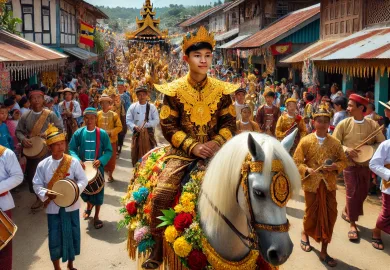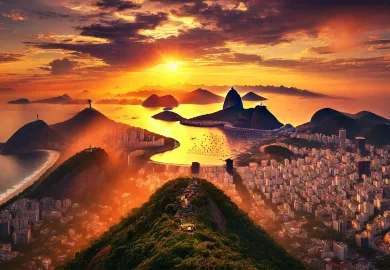
The Virgen del Carmen Festival in Paucartambo, Peru, is a vibrant and deeply spiritual celebration that stands as a testament to the rich cultural heritage of the Andean region. Held annually in mid-July, this festival honors the Virgen del Carmen, also known as “Mamacha Carmen,” the patron saint of Paucartambo and one of the most revered figures in Peruvian Catholicism. The event draws thousands of pilgrims, tourists, and locals to the small town of Paucartambo, turning it into a kaleidoscope of color, music, dance, and religious fervor. This article delves into the historical roots, cultural significance, and unique traditions of the Virgen del Carmen Festival, offering a comprehensive guide to one of Peru’s most spectacular fiestas.
The Historical Roots of the Virgen del Carmen Festival
The Virgen del Carmen Festival in Paucartambo has deep historical roots that trace back to the Spanish colonial period. The festival is believed to have originated in the 17th century, when Spanish missionaries introduced Catholicism to the indigenous communities of the Andean region. The Virgin of Carmen, known for her role as a protector and intercessor, quickly became a beloved figure among the local population.
During the colonial period, the festival served as a means of religious conversion and cultural assimilation. The Spanish authorities used the celebration to promote Catholicism while incorporating elements of indigenous beliefs and practices, creating a syncretic religious tradition that endures to this day. Over the centuries, the festival has evolved, blending Catholic rituals with Andean customs, resulting in a unique and vibrant expression of faith that reflects the cultural diversity of the region.
Today, the Virgen del Carmen Festival is not only a religious event but also a celebration of Paucartambo’s identity and heritage. It is a time when the town comes alive with traditional music, dance, and art, drawing visitors from all over the world who come to witness the spectacle and participate in the festivities.
The Spiritual Significance of the Virgen del Carmen
At the heart of the Virgen del Carmen Festival is a deep sense of spirituality and devotion to the Virgin Mary. The Virgen del Carmen is regarded as the protector of the faithful, particularly those who live in the Andean highlands. She is believed to intercede on behalf of her devotees, offering protection from natural disasters, illness, and other dangers.
The festival is marked by a series of religious ceremonies, including masses, processions, and prayers dedicated to the Virgen del Carmen. The central event is the grand procession of the Virgin’s statue through the streets of Paucartambo. This procession is a powerful expression of faith, as thousands of people follow the statue, singing hymns, praying, and seeking blessings.
One of the most poignant moments of the festival is the “Salida de la Virgen,” or the “Departure of the Virgin.” During this ceremony, the statue of the Virgen del Carmen is carried out of the church and paraded through the town. The atmosphere is charged with emotion as devotees reach out to touch the statue or throw flower petals in her path. This act of devotion is believed to bring protection and good fortune to those who participate.
In addition to the religious aspects, the festival also includes traditional Andean rituals, such as the “Pago a la Tierra” (Payment to the Earth), which reflects the deep connection between the people and the natural world. This ritual, performed by local shamans, involves offering gifts to Pachamama (Mother Earth) in gratitude for her blessings and to ensure the fertility of the land.
The Vibrant Traditions and Dances of Paucartambo
The Virgen del Carmen Festival is renowned for its vibrant and colorful traditions, particularly the traditional dances that are performed throughout the celebration. These dances are not only a form of entertainment but also a means of preserving and transmitting cultural knowledge and history.
One of the most iconic dances of the festival is the “Qhapaq Qolla,” which tells the story of the Qollas, ancient traders from the highlands who traveled to Paucartambo to exchange goods. The dancers wear elaborate costumes, including masks and headdresses adorned with feathers, representing the Qollas and their journey. The dance is characterized by energetic movements and intricate choreography, symbolizing the strength and resilience of the Andean people.
Another popular dance is the “Qhapaq Negro,” which depicts the experiences of African slaves brought to Peru during the colonial period. The dancers, dressed in black costumes and masks, perform a lively and rhythmic dance that reflects the struggles and triumphs of the Afro-Peruvian community. This dance is a powerful reminder of the diverse cultural influences that have shaped Peruvian society.
The “Majeño” dance is also a highlight of the festival, celebrating the mestizo culture that emerged from the blending of Spanish and indigenous traditions. The dancers, dressed in elegant colonial-style costumes, perform a graceful and dignified dance that pays homage to the rich cultural heritage of Paucartambo.
These dances are accompanied by traditional Andean music, played on instruments such as the charango, quena, and panpipes. The music, with its haunting melodies and rhythmic beats, adds to the festive atmosphere and provides a soundtrack for the celebration.
Experiencing the Virgen del Carmen Festival as a Visitor
For visitors, the Virgen del Carmen Festival offers a unique opportunity to immerse themselves in the rich cultural and spiritual traditions of the Andean region. The town of Paucartambo, located about 109 kilometers from Cusco, provides a picturesque setting for the festival, with its colonial architecture, narrow streets, and stunning mountain views.
Visitors are welcomed with open arms by the local community, who are eager to share their traditions and hospitality. Accommodations in Paucartambo are limited, so it is advisable to book in advance or consider staying in nearby Cusco and making a day trip to the festival. The journey from Cusco to Paucartambo takes approximately four hours by bus or car, offering travelers a scenic drive through the Andean highlands.
The festival officially begins on July 15th and continues for several days, with the main events taking place on July 16th, the feast day of the Virgen del Carmen. On this day, the town is filled with processions, dance performances, and religious ceremonies. The streets are lined with vendors selling traditional food, crafts, and souvenirs, allowing visitors to sample local cuisine and take home a piece of Paucartambo’s culture.
One of the highlights for visitors is the “Guerrilla,” a playful mock battle between two groups of dancers representing the forces of good and evil. This event takes place on the final day of the festival and is a thrilling spectacle of choreography, music, and theatricality. The “Guerrilla” ends with the triumph of the forces of good, symbolizing the victory of the Virgen del Carmen over evil.
Attending the Virgen del Carmen Festival is not just about witnessing the events but also participating in the communal spirit of the celebration. Visitors are encouraged to join the processions, dance with the locals, and experience the deep sense of faith and community that permeates the festival. It is an opportunity to connect with the people of Paucartambo and gain a deeper understanding of their culture and beliefs.
A Journey to the Heart of Andean Spirituality
The Virgen del Carmen Festival in Paucartambo is more than just a religious celebration; it is a journey to the heart of Andean spirituality and culture. The festival provides a rare glimpse into the syncretic traditions that have shaped the identity of the Andean people, blending Catholicism with indigenous beliefs in a way that is both unique and profoundly moving.
For those who are passionate about cultural exploration, the festival offers an unparalleled experience of living history and tradition. It is a reminder of the resilience and creativity of the Andean communities, who have preserved their customs and beliefs through centuries of change and adversity.
As the festival draws to a close each year, the people of Paucartambo look forward to the next celebration, when they will once again honor the Virgen del Carmen and reaffirm their connection to their spiritual and cultural roots. For visitors, the festival leaves an indelible impression, a reminder of the richness of Peru’s cultural heritage and the enduring power of faith.
Whether you are a seasoned traveler or a first-time visitor to Peru, the Virgen del Carmen Festival in Paucartambo is an event that should not be missed. It is a celebration that transcends the boundaries of time and place, inviting all who attend to join in the dance of life, faith, and tradition.








